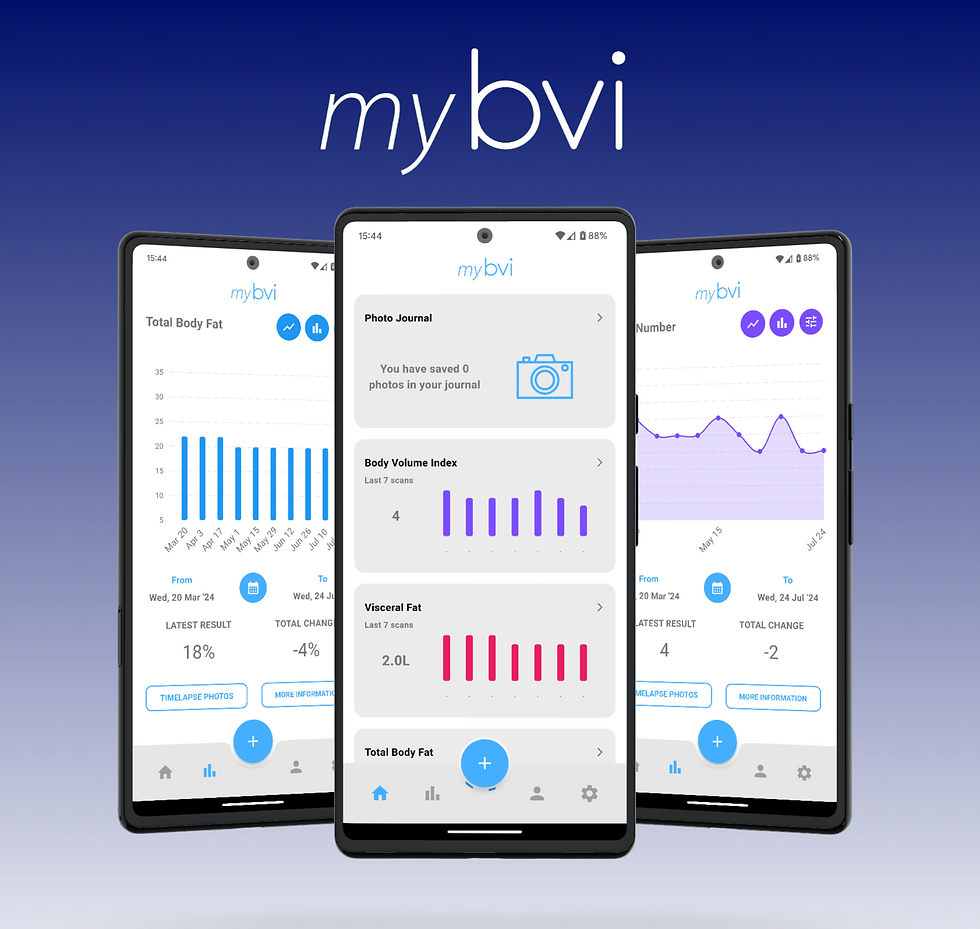What is 3D Scanning Used For?
- Select Research

- Aug 28, 2024
- 3 min read
__________________________________________________________________________________
Introduction
3D scanning is mostly used for collecting data from static objects in design and manufacturing. However, there are equally valid applications for measuring the human body in 3D.
In the ever-evolving world of healthcare technology, few innovations hold as much promise as 3D body scanning and mobile health applications. A pioneering study, recently published in the European Heart Journal, has validated the use of our advanced 3D body volume (3D-BV) scanning technology and mobile application (myBVI) as powerful tools for predicting metabolic syndrome (MS), a serious health condition affecting millions worldwide.
This recent research not only demonstrates the superior accuracy of our 3D body scanning technology compared to traditional methods but also underscores the transformative potential of mobile technology in healthcare. By validating these tools, the study paves the way for a new era in health assessment, where technology is central to improving patient outcomes and making health monitoring more accessible to everyone.
A New Approach: The Power of 3D Body Scanning
Recent studies, including one in the European Heart Journal, have been exploring how 3D-BV scanner technology can predict metabolic syndrome more accurately than traditional methods. Our technology creates a detailed 3D model of your body, providing precise measurements far more detailed than those obtained from conventional tools. This detailed analysis is crucial because fat distribution in the body, particularly around the abdomen, can significantly impact metabolic health (Stefan, 2020).
Combining Demographics with 3D Body Scanning
Beyond just capturing a 3D image, we developed a new metric called the Body Volume Index (BVI). Unlike the outdated BMI, which only considers height and weight (Nuttall, 2015), BVI combines demographic information such as age, sex, and race with detailed body volume measurements to measure weight distribution. This results in more personalised assessment of health risks. The study found that the BVI model predicted metabolic syndrome with an accuracy rate (AUC) of 0.83, significantly better than traditional methods like BMI and waist-to-hip ratio (WHR).

Enter Mobile Technology: The myBVI® App
The myBVI app uses a smartphone camera to take front-facing and side-facing photos, which it then analyses to estimate body volumes. This app essentially puts the power of a 3D scanner in your pocket. In the study, the app showed an accuracy rate (AUC) of 0.88 in predicting metabolic syndrome, making it a valuable tool for health assessment anywhere, anytime.
Why Does This Matter?
Why are these technological advancements important? They provide a more comprehensive understanding of health than traditional methods like BMI and waist circumference, which often miss critical information about muscle mass and fat distribution. This is important because the same volume of muscle weighs more than the same volume of fat. With the myBVI app, individuals and healthcare providers gain a clearer, more accurate picture of health, enabling more personalised and effective interventions.
The Future of Health: What’s Next?
The potential for BVI mobile scanning technology in healthcare is enormous. As these tools become more accessible, they could be used not just in medical settings but also in gyms, wellness centers, and homes. Imagine assessing your metabolic health risk using only your smartphone—no special equipment or appointments needed. This accessibility could encourage more people to monitor their health regularly, make proactive lifestyle changes, and ultimately reduce the risk of developing metabolic syndrome and other related health issues.
Moreover, this technology could integrate via an API with other digital health platforms, making it easier for healthcare providers to monitor and manage patients’ health over time. This could lead to earlier detection of metabolic syndrome and more timely interventions, potentially preventing serious health complications.

__________________________________________________________________________________
Conclusion
These new tools offer a more accurate and detailed assessment of metabolic health than ever before, with the myBVI app making it accessible to anyone. As technology continues to advance, we can look forward to innovative solutions that help combat the growing epidemic of metabolic syndrome. The combination of technology and health is just beginning, and the future holds exciting possibilities for empowering individuals and healthcare providers in managing health more effectively.
About the Author:
This blog post is inspired by a Mayo Clinic study published in the European Heart Journal, which explored the exciting potential of advanced body volume scanning and mobile technology in predicting metabolic syndrome.
Link to article: Prediction of presence and severity of metabolic syndrome using regional body volumes measured by a multisensor white-light 3D scanner and validation using a mobile technology | European Heart Journal - Digital Health | Oxford Academic (oup.com)
References
Nuttall, F. (2015). Body Mass Index, Obesity, BMI, and Health: A Critical Review. Nutrition Today, (50)3, 117-128.
Stefan, N. (2020). Causes, consequences, and treatment of metabolically unhealthy fat distribution. Diabetes & Endocrinology, (8)7, 616-627.









Comments